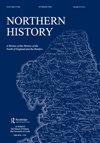RICHARD SHARPE (Ed.), with contributions by JANET BURTON, MICHAEL GULLICK and NICHOLAS KARN, Foundation Documents from St Mary’s Abbey, York: 1085–1137, Surtees Society Publications, Vol. CCXXVII
IF 0.2
3区 历史学
Q2 HISTORY
引用次数: 0
Abstract
work. Acca of Hexham who commissioned some of Bede’s theological works is seen as a major influence, particularly on matters to do with Bishop Wilfrid. Acca’s removal from office in 731 meant that some aspects had to be suppressed and he is not acknowledged in the Preface. King Ceolwulf is seen as a more commanding influence than has often been the case. Ceolwulf retired to the monastery of Lindisfarne in 737, and it is suggested that the emphases on the need for church reform and on the achievements of Bishop Aidan and of other Irish missionaries from the monastery reflect the king’s influence. A marked change in approach can certainly be seen from the chronicle that Bede appended to De Temporum Ratione (probably completed in 725) in which no reference is made to Aidan or any of his associates. But the emphasis on the patrons produces a Bede who is something of a cipher, merely writing what he has been told to do, which does not seem to fit comfortably with his confidence as a theological commentator in the tradition of the Fathers of the Church. The praise of Aidan seems too heartfelt not to be Bede’s own, and as he had his own links with Lindisfarne, Bede presumably had his own impressions to draw upon. But Shaw admits that he has only been able to concentrate on some facets, and that a wider study of all Bede’s sources of information is needed to put the work fully in context. Shaw devotes more space to When and Why than to How. He produces a calculation table and suggests Bede prepared something similar to date events by a variety of means and to get them in order. The table consists in modern print of 18 double pages each with 16 columns. This is relatively straightforward to set out with a modern computer, but how would Bede have managed it with parchment and waxed tablets? We are still far from knowing all that is to be known about the construction of the Ecclesiastical History, but Shaw throws up many questions that need to be asked even if certain answers may be hard to come by. He has read very widely and thoroughly, and his book provides an excellent overview of the current state of play in the study of Bede’s most famous work. Prospective readers may, however, want to wait for the appearance of a paperback edition, as the hardback is an eyewatering £120 for 300 pages (though an ebook is also available).RICHARD SHARPE(编),与JANET BURTON, MICHAEL GULLICK和NICHOLAS KARN的贡献,圣玛丽修道院基金会文件,约克:1085-1137,Surtees Society Publications, Vol. CCXXVII
工作。赫克瑟姆的阿卡委托了比德的一些神学作品,被认为是一个主要的影响,特别是在与威尔弗里德主教有关的问题上。阿卡在731年被免职意味着某些方面必须被压制,他在序言中没有得到承认。与以往相比,塞奥武夫国王被认为具有更大的影响力。Ceolwulf于737年退休到Lindisfarne修道院,有人认为强调教会改革的必要性以及主教Aidan和其他来自修道院的爱尔兰传教士的成就反映了国王的影响。从比德所附的编年史(可能完成于725年)中可以明显看出,他的做法发生了明显的变化,其中没有提到艾丹或他的任何同伙。但是,对赞助人的强调造就了一个比德,他有点像个密码,只是写他被告知要做的事情,这似乎与他作为教会教父传统中的神学评论员的自信不太相符。对艾丹的赞美似乎太过真诚而不是比德自己的,因为他与林迪斯法恩有自己的联系,比德大概有自己的印象可以借鉴。但肖承认,他只能专注于某些方面,需要对比德的所有信息来源进行更广泛的研究,才能将这项工作完全置于背景中。肖把更多的篇幅放在了“何时”和“为什么”上,而不是“如何”上。他制作了一个计算表,并建议比德准备一些类似的东西,通过各种方式确定事件的日期,并将它们按顺序排列。表格采用现代印刷,共18页,每页16列。用现代电脑来做这个比较简单,但比德用羊皮纸和蜡笔写的平板电脑会怎么做呢?我们还远远没有完全了解教会史的结构,但肖提出了许多需要问的问题,即使某些答案可能很难得到。他读得非常广泛而深入,他的书对比德最著名的作品的研究现状提供了一个很好的概述。然而,潜在的读者可能希望等待平装本的出现,因为精装本的300页售价高达120英镑(尽管电子书也可以买到)。
本文章由计算机程序翻译,如有差异,请以英文原文为准。
求助全文
约1分钟内获得全文
求助全文
来源期刊

Northern History
Multiple-
CiteScore
0.20
自引率
33.30%
发文量
37
期刊介绍:
Northern History was the first regional historical journal. Produced since 1966 under the auspices of the School of History, University of Leeds, its purpose is to publish scholarly work on the history of the seven historic Northern counties of England: Cheshire, Cumberland, Durham, Lancashire, Northumberland, Westmorland and Yorkshire. Since it was launched it has always been a refereed journal, attracting articles on Northern subjects from historians in many parts of the world.
 求助内容:
求助内容: 应助结果提醒方式:
应助结果提醒方式:


